Reimagined ATrim XVIIIb.1
Jul 19, 2022 2:07:46 GMT
Post by Razor on Jul 19, 2022 2:07:46 GMT
Reimagined ATrim XVIIIb.1
By Ray Harrington
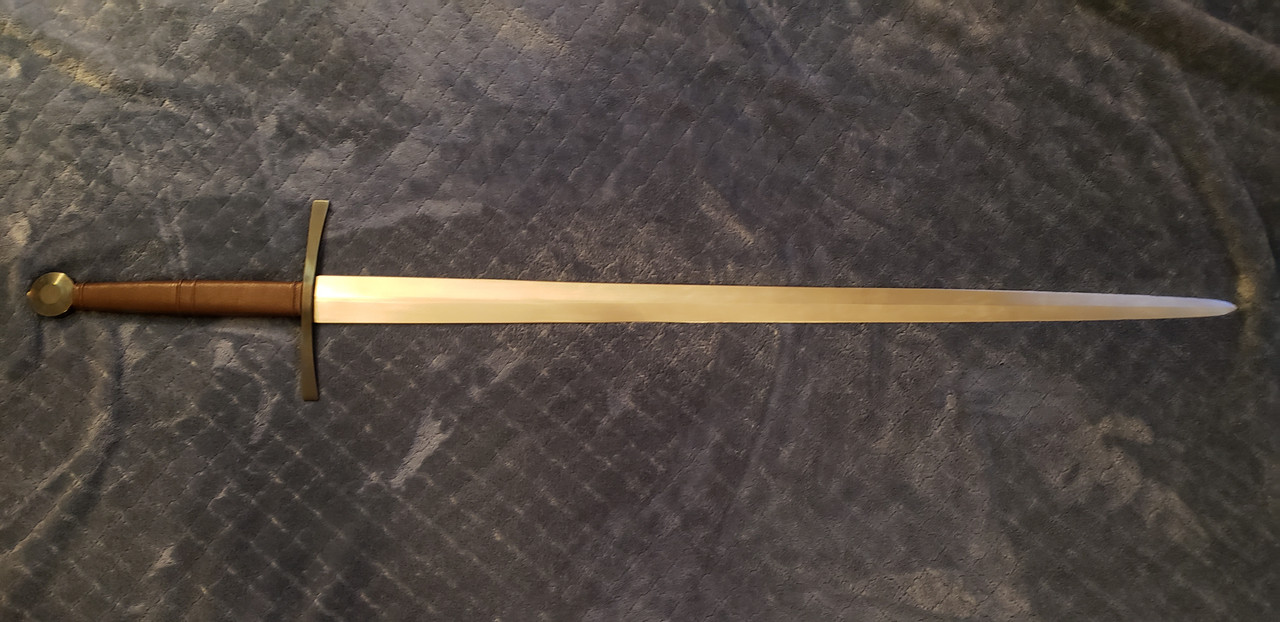
Introduction
Knowing that I have an AT1520 (aka XVIIIb.1), Gus asked if I would like to try out the new one and compare the two for a review. I was excited to except the offer. For the review I will refer the reimagined longsword as "B.1" and the older longsword as "1520".
Full Disclosure
Gus has sent swords to try out and sell at my sword gatherings/cutting parties, and this is the second sword he sent me for a review.
I do not work for ATrim nor did I buy this sword. When I'm done with the review I will be sending the sword back.
AT1520
Gus says my 1520 was made before 2007. I bought it second hand from Yeshua's Sword. Yeshua's Swords made a sent stopper pommel and hot blued the pommel and the original cross guard. Yeshua's Sword did a fantastic job with keeping the weight of the new pommel the same as the original pommel.
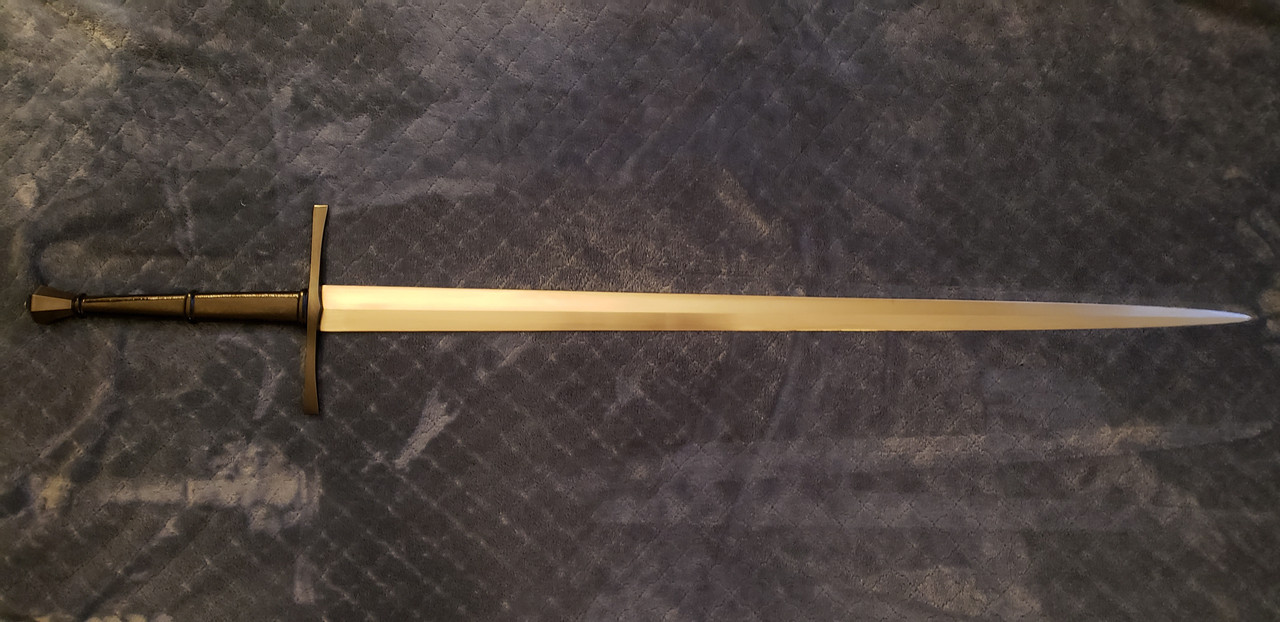
Original Pommel
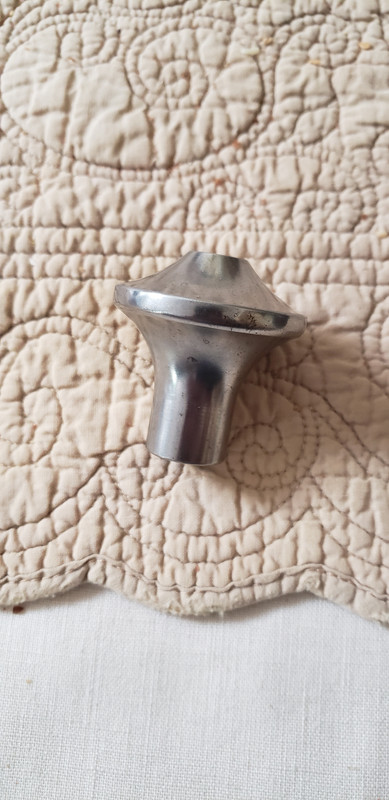
Initial Impression
When first picking up the sword I could really feel the blade presence. I could tell the blade on the B.1 is wider and heavier than the 1520. The B.1 seems to lean closer to a warsword than a longsword.

Statistics
B.1 1520
Overall Length: 48" Overall Length: 48"
Blade Length: 37" Blade Length: 36 1/2"
Handle Length: 9" Handle Length: 9"
POB: 5 1/2" POB: 4"
COB: 23" COB: 21 1/2"
Weight: 3.06 lbs Weight: 2.53 lbs
Thickness Thickness
At The Cross Guard: .25" At The Cross Guard: .19"
POB: .23" POB: .17"
COB: .17" COB: .15"
3" From The Tip: .11" 3" From The Tip: .09"
1" From The Tip: .9" 1" From The Tip: .08"
Width Width
At The Cross Guard: 1 7/8" At The Cross Guard: 1 13/16"
POB: 1 13/16" POB: 1 11/16"
COB: 1 3/8" COB: 1 5/16"
3" From The Tip: 7/8" 3" From The Tip: 3/4"
1" From The Tip: 5/8" 1" From The Tip: 3/8"
ATrim XVIIIb.1
Gus, looks at the whole thing about swords differently than he did 18 years ago. His perspective is quite different. The idea for the 1520 was to look as much as possible to the originals. Gus told me that he missed the 3d part of it. His emphasis changed since then, and wanted his blade geometry to be closer to historical accuracy. With this manner, he can get his swords closer to historical handling. The forte was thickened to stiffen it up so it would be more rigid than the 1520. Striking the pommel on both swords, I can really see the difference in the forte between the two. The B.1's forte is noticeably more rigid than the 1520's forte. There is a good amount of vibration on the forte when striking B.1's pommel. It's not as pronounced like it is on 1520's forte.
B.1 Blade
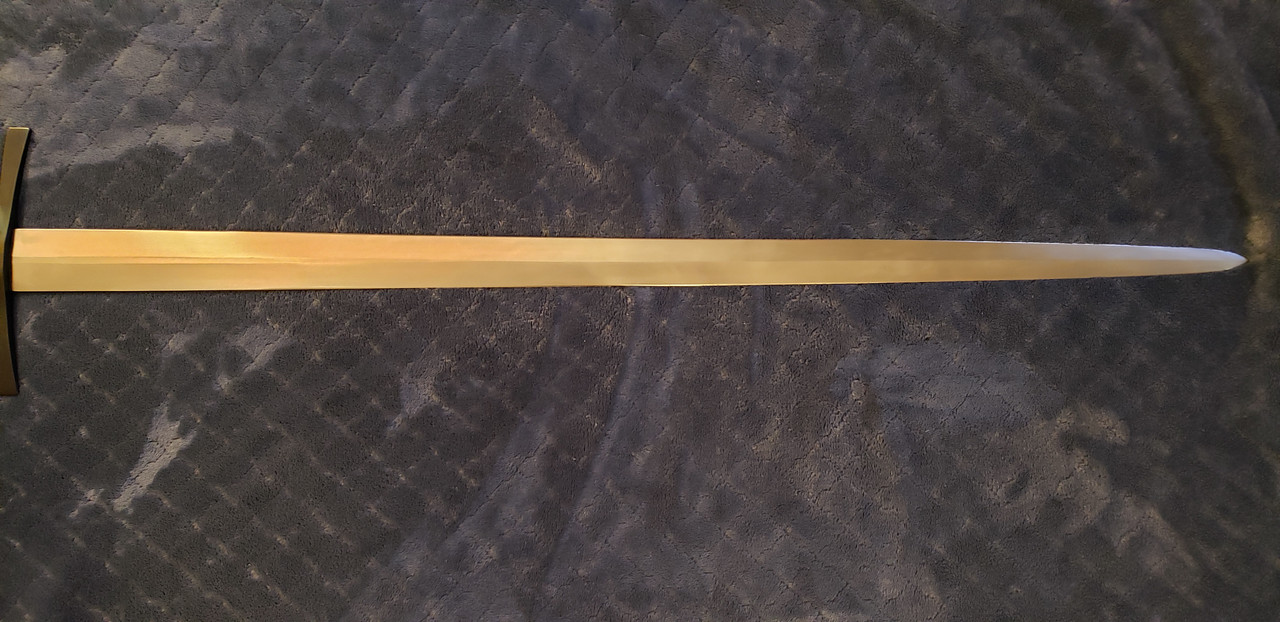
B.1 Hilt
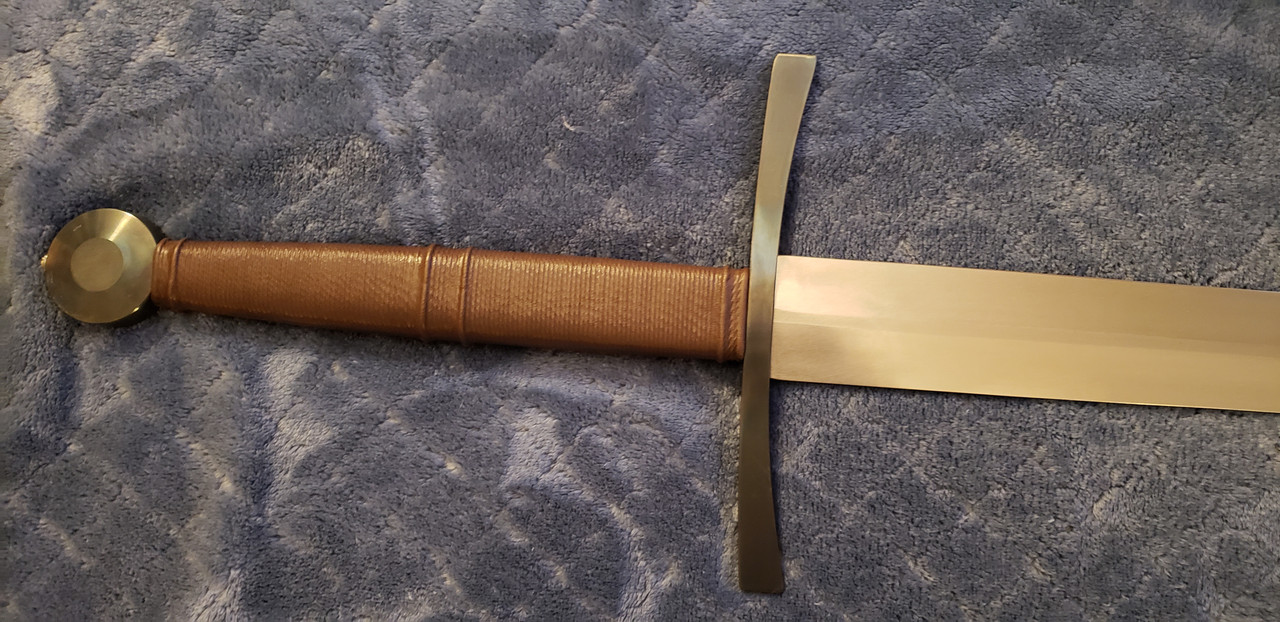
Comparison
These swords are two different beasts. B1 is thicker, wider, and heavier than the 1520 making the handling characteristic very different. 1520 is agile, fast, and I have full control. Even with a cut I can stop it on a dime. With the B.1 having more of a forward blade presence it isn't as fast or agile as the 1520. I don't have as much control that I do with the 1520. Striking a blow with the B.1, the forward blade presence leads the blow and hits the target with authority but sacrifices some of the control.
A longsword is a two handed sword that is balanced to be usable in one hand. The 1520 fits that definition where the B.1 not so much. The B.1 leans closer to a warsword/true two-handed sword. I can swing the B.1 with one hand but without a lot of control. With the balance of the B.1, I do not have the dexterity to fight with it one handed. I'm confidant in using the 1520 in one hand even though it wouldn't be as dexterous as a single hand sword.

Blades
1520 is on top and B.1 is on the bottom.
Another noticeable deference between these two swords are the points of the blades. 1520's blade tappers to a acutely sharp point. The B.1's blade is wider and graceful, and curves to a sharp point in the last couple of inches. Both tips fit the characteristics of type XVIII's swords, where 1520's tip resembles more of the sub-type XVIIIb.
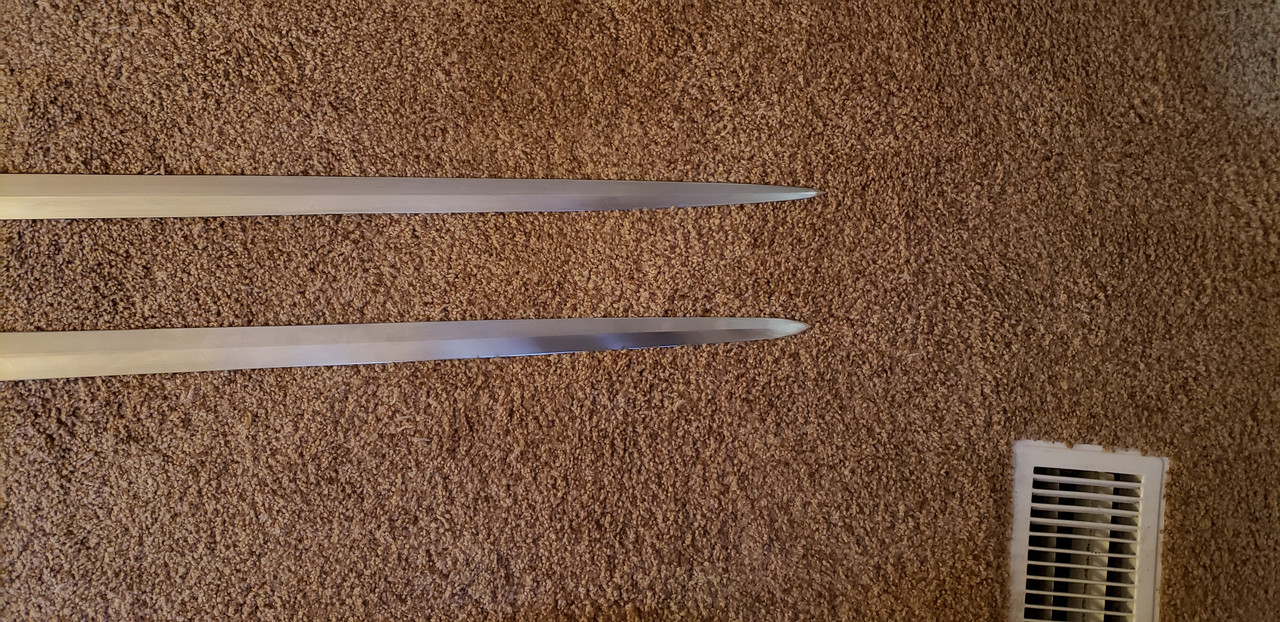
Gus purposely designed B.1 point to be wider to be able to do tip cuts on heavier clothing.
Cutting Video B.1
As you can see in the video, the sword cuts amazingly. I wouldn't expect anything less from a Atrim.
Cutting Videos 1520
These three videos were taken at two of my sword gathering/ cutting parties with the original pommel. The first video was taken seven years ago and the other two six years ago.
As you can see in the videos, both these longswords perform essentially well.
Thank you for checking out my review.
Ray
By Ray Harrington

Introduction
Knowing that I have an AT1520 (aka XVIIIb.1), Gus asked if I would like to try out the new one and compare the two for a review. I was excited to except the offer. For the review I will refer the reimagined longsword as "B.1" and the older longsword as "1520".
Full Disclosure
Gus has sent swords to try out and sell at my sword gatherings/cutting parties, and this is the second sword he sent me for a review.
I do not work for ATrim nor did I buy this sword. When I'm done with the review I will be sending the sword back.
AT1520
Gus says my 1520 was made before 2007. I bought it second hand from Yeshua's Sword. Yeshua's Swords made a sent stopper pommel and hot blued the pommel and the original cross guard. Yeshua's Sword did a fantastic job with keeping the weight of the new pommel the same as the original pommel.

Original Pommel

Initial Impression
When first picking up the sword I could really feel the blade presence. I could tell the blade on the B.1 is wider and heavier than the 1520. The B.1 seems to lean closer to a warsword than a longsword.

Statistics
B.1 1520
Overall Length: 48" Overall Length: 48"
Blade Length: 37" Blade Length: 36 1/2"
Handle Length: 9" Handle Length: 9"
POB: 5 1/2" POB: 4"
COB: 23" COB: 21 1/2"
Weight: 3.06 lbs Weight: 2.53 lbs
Thickness Thickness
At The Cross Guard: .25" At The Cross Guard: .19"
POB: .23" POB: .17"
COB: .17" COB: .15"
3" From The Tip: .11" 3" From The Tip: .09"
1" From The Tip: .9" 1" From The Tip: .08"
Width Width
At The Cross Guard: 1 7/8" At The Cross Guard: 1 13/16"
POB: 1 13/16" POB: 1 11/16"
COB: 1 3/8" COB: 1 5/16"
3" From The Tip: 7/8" 3" From The Tip: 3/4"
1" From The Tip: 5/8" 1" From The Tip: 3/8"
ATrim XVIIIb.1
Gus, looks at the whole thing about swords differently than he did 18 years ago. His perspective is quite different. The idea for the 1520 was to look as much as possible to the originals. Gus told me that he missed the 3d part of it. His emphasis changed since then, and wanted his blade geometry to be closer to historical accuracy. With this manner, he can get his swords closer to historical handling. The forte was thickened to stiffen it up so it would be more rigid than the 1520. Striking the pommel on both swords, I can really see the difference in the forte between the two. The B.1's forte is noticeably more rigid than the 1520's forte. There is a good amount of vibration on the forte when striking B.1's pommel. It's not as pronounced like it is on 1520's forte.
B.1 Blade

B.1 Hilt

Comparison
These swords are two different beasts. B1 is thicker, wider, and heavier than the 1520 making the handling characteristic very different. 1520 is agile, fast, and I have full control. Even with a cut I can stop it on a dime. With the B.1 having more of a forward blade presence it isn't as fast or agile as the 1520. I don't have as much control that I do with the 1520. Striking a blow with the B.1, the forward blade presence leads the blow and hits the target with authority but sacrifices some of the control.
A longsword is a two handed sword that is balanced to be usable in one hand. The 1520 fits that definition where the B.1 not so much. The B.1 leans closer to a warsword/true two-handed sword. I can swing the B.1 with one hand but without a lot of control. With the balance of the B.1, I do not have the dexterity to fight with it one handed. I'm confidant in using the 1520 in one hand even though it wouldn't be as dexterous as a single hand sword.

Blades
1520 is on top and B.1 is on the bottom.
Another noticeable deference between these two swords are the points of the blades. 1520's blade tappers to a acutely sharp point. The B.1's blade is wider and graceful, and curves to a sharp point in the last couple of inches. Both tips fit the characteristics of type XVIII's swords, where 1520's tip resembles more of the sub-type XVIIIb.

Gus purposely designed B.1 point to be wider to be able to do tip cuts on heavier clothing.
Cutting Video B.1
As you can see in the video, the sword cuts amazingly. I wouldn't expect anything less from a Atrim.
Cutting Videos 1520
These three videos were taken at two of my sword gathering/ cutting parties with the original pommel. The first video was taken seven years ago and the other two six years ago.
As you can see in the videos, both these longswords perform essentially well.
Thank you for checking out my review.
Ray




 Unfortunately I'm an edge-perfectionist. Also one wrong move when unsheathing and the throat nicks the edge on either side.
Unfortunately I'm an edge-perfectionist. Also one wrong move when unsheathing and the throat nicks the edge on either side.
